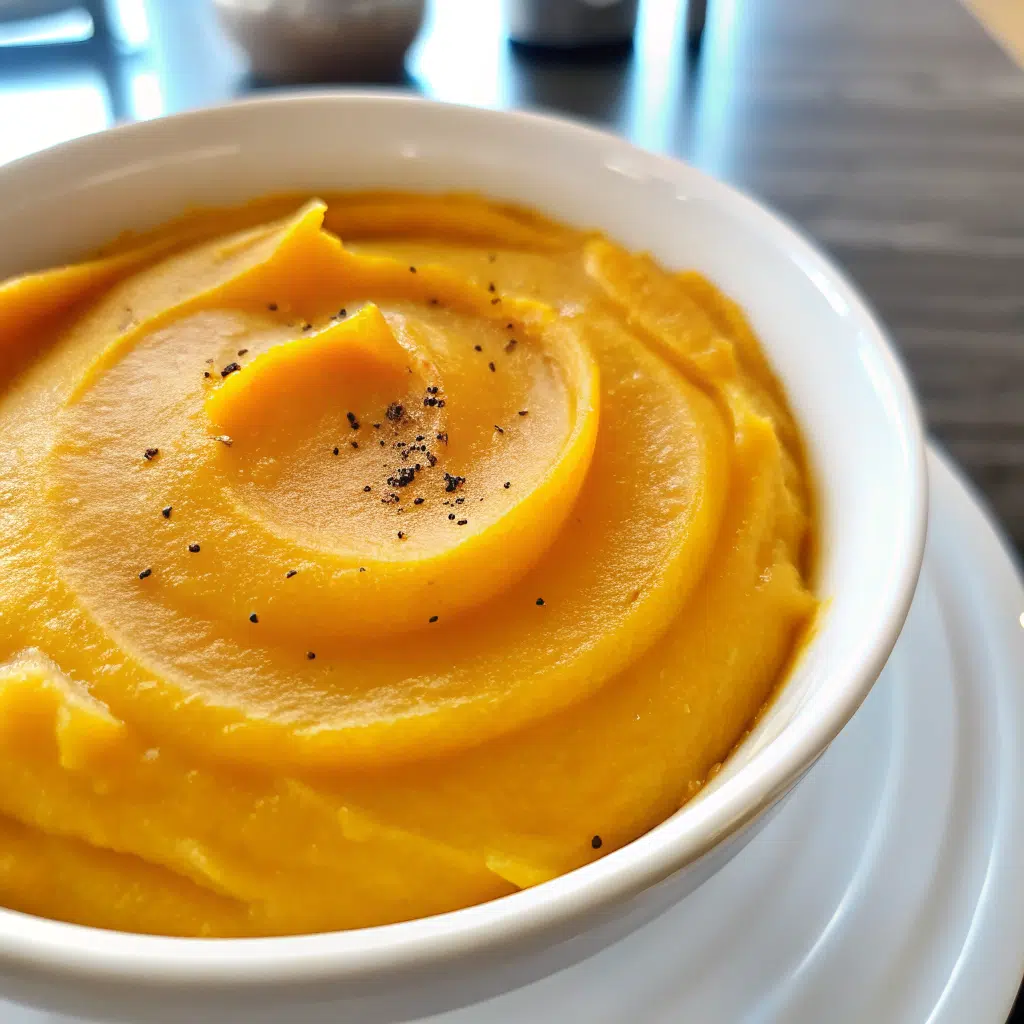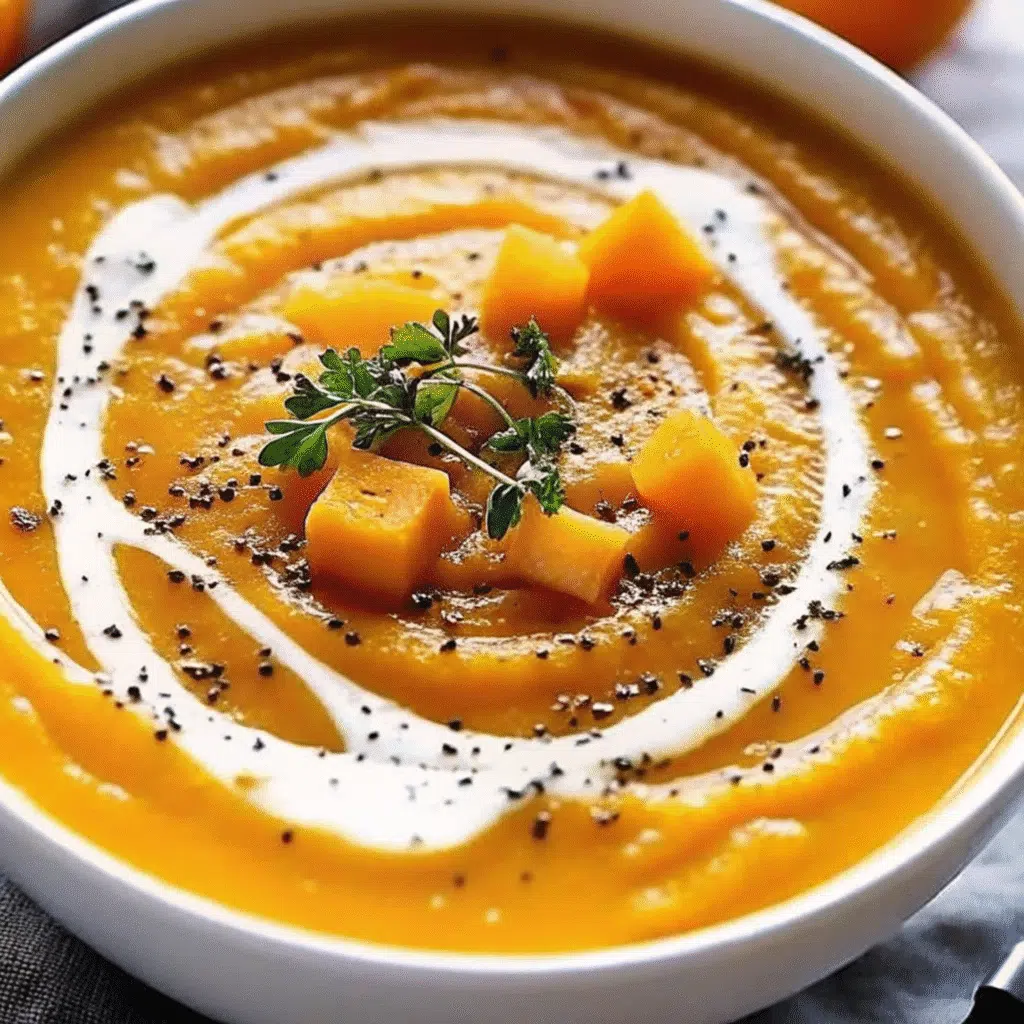Gordon Ramsay Butternut Squash Soup completely changed how I think about making soup. The secret? Caramelizing the squash until it’s sweet and golden, and sautéing the aromatics just right—no cream or butter needed. The result is rich, creamy, and packed with flavor. Now my kids won’t stop asking for “that orange soup” every weekend!
Love Butternut Squash Recipes? Try my Butternut Squash Lasagna Soup with Kale and Mozzarella or this Spicy Butternut Squash Pasta next.

Why You’ll Love This Recipe
So I’m gonna be honest – I’m usually not the person who follows celebrity chef recipes because they seem all complicated and fancy. But my mom kept bugging me to try this after she saw it on some cooking show. The squash gets all sweet and caramelized, which I didn’t even know was a thing you could do to vegetables. My 16-year-old ate two bowls and asked if we could have it again next week. That never happens with vegetables in my house.
Print
Gordon Ramsay Butternut Squash Soup
- Total Time: 50 minutes
- Yield: About 6 cups
Description
Learn how to make Gordon Ramsay’s famous butternut squash soup using his professional technique of caramelizing the squash and building aromatic layers for incredible depth of flavor. This dairy-free, vegan recipe creates a luxuriously creamy texture without any cream.
Ingredients
For the Soup:
- 1 big butternut squash (mine was about 3 pounds)
- 1 yellow onion
- 4 garlic cloves
- 1 tablespoon fresh ginger (the knobby root, not powder)
- 2 tablespoons fresh sage leaves
- 1 tablespoon fresh rosemary
- 3 tablespoons olive oil
- 4–5 cups vegetable broth (keep the carton handy)
- Salt and pepper
If you want to get fancy:
- Extra sage leaves to fry up
- Pumpkin seeds from the squash
- Good olive oil for drizzling
Instructions
Step 1: Cut everything up first (10 minutes) This is boring but necessary. Get your squash peeled and chopped into chunks – doesn’t have to be perfect, just roughly the same size. Chop your onion, smash and chop the garlic, grate the ginger (watch your knuckles), and chop up the herbs. I learned to do this first because once you start cooking, everything happens fast and you don’t want to be frantically chopping while your squash burns.
Step 2: The part that seemed weird but actually works (8-10 minutes) Heat up your oil in a big pot. Add the squash chunks and then – this is important – DON’T TOUCH THEM. I know you want to stir them around, but don’t. Let them just sit there for like 4 minutes. When you finally do stir them, you’ll see these brown, caramelized edges that smell amazing. Keep cooking and stirring occasionally until they’re golden in spots.
Step 3: Add the smelly good stuff (3-4 minutes) Push all your beautiful squash to one side of the pot (yes, really, just shove it over) and add a bit more oil to the empty space. Throw in your onion and let it get soft and see-through. Then add the garlic, ginger, and herbs. This part smells incredible – like 30 seconds and your whole kitchen smells like a fancy restaurant.
Step 4: Add liquid and wait (25 minutes) Pour in your broth and scrape up any brown bits stuck to the bottom with your spoon – that’s flavor. Let it bubble up, then turn the heat down low, put a lid on it, and let it cook for about 25 minutes. The squash should be really soft when you poke it with a fork.
Step 5: Make it smooth (3-4 minutes) I use one of those stick blenders right in the pot because I’m lazy and don’t want to wash extra dishes. Blend it until it’s smooth, adding more broth if it seems too thick. Taste it and add salt and pepper. Prepare to be shocked at how creamy it is without any cream.
Notes
Don’t put too much squash in the pot at once when you’re browning it. I did this the first time and it just steamed instead of getting those crispy edges. If your pot looks crowded, do half the squash, take it out, then do the other half.
Keep extra broth around. I made the soup way too thick once and had to add water, which made it taste watery and sad. Now I always keep the carton next to the stove.
The herbs have to go in at exactly the right time. Too early and they taste bitter, too late and they don’t do anything. When the oil is hot but not smoking, that’s when you add them.
Don’t blend it to death. I did this once and it got all foamy and weird instead of smooth and creamy. Just blend until it’s smooth, then stop.
- Prep Time: 15 minutes
- Cook Time: 35 minutes
- Category: Soup, Appetizer
- Method: Sautéing, Simmering
Ingredient List
For the Soup:
- 1 big butternut squash (mine was about 3 pounds)
- 1 yellow onion
- 4 garlic cloves
- 1 tablespoon fresh ginger (the knobby root, not powder)
- 2 tablespoons fresh sage leaves
- 1 tablespoon fresh rosemary
- 3 tablespoons olive oil
- 4-5 cups vegetable broth (keep the carton handy)
- Salt and pepper
If you want to get fancy:
- Extra sage leaves to fry up
- Pumpkin seeds from the squash
- Good olive oil for drizzling
Real talk: If you can only find dried herbs, use about 1 teaspoon dried sage and half a teaspoon dried rosemary. It won’t be quite the same, but it’ll still work. And please don’t use powdered ginger if you can help it – the fresh stuff makes such a difference.
Why These Ingredients Work
I used to think cooking was just throwing ingredients together and hoping for the best. But there’s actually some method to this madness. When you cube up that squash and let it sit in the hot oil without touching it, something happens – the edges get all brown and crispy, and it starts smelling like candy. I swear I’m not making this up.
The ginger was weird to me at first. I thought it would make the soup spicy, but it doesn’t. It just adds this warmth that makes the whole thing taste cozy. And the sage and rosemary? I used to buy those little plastic containers and never use them, but now I get it. They make everything smell like Thanksgiving dinner. The olive oil does something too – makes it feel rich even though there’s no butter or cream in there.
Essential Tools and Equipment
You probably have most of this stuff already:
- A big pot (I use my Dutch oven)
- Sharp knife for the squash (seriously, this matters)
- Cutting board
- Something to blend with (I have one of those stick blenders, but a regular blender works too)
- Wooden spoon
- Measuring stuff
How To Make Gordon Ramsay Butternut Squash Soup
Step 1: Cut everything up first (10 minutes) This is boring but necessary. Get your squash peeled and chopped into chunks – doesn’t have to be perfect, just roughly the same size. Chop your onion, smash and chop the garlic, grate the ginger (watch your knuckles), and chop up the herbs. I learned to do this first because once you start cooking, everything happens fast and you don’t want to be frantically chopping while your squash burns.
Step 2: The part that seemed weird but actually works (8-10 minutes) Heat up your oil in a big pot. Add the squash chunks and then – this is important – DON’T TOUCH THEM. I know you want to stir them around, but don’t. Let them just sit there for like 4 minutes. When you finally do stir them, you’ll see these brown, caramelized edges that smell amazing. Keep cooking and stirring occasionally until they’re golden in spots.
Step 3: Add the smelly good stuff (3-4 minutes) Push all your beautiful squash to one side of the pot (yes, really, just shove it over) and add a bit more oil to the empty space. Throw in your onion and let it get soft and see-through. Then add the garlic, ginger, and herbs. This part smells incredible – like 30 seconds and your whole kitchen smells like a fancy restaurant.
Step 4: Add liquid and wait (25 minutes) Pour in your broth and scrape up any brown bits stuck to the bottom with your spoon – that’s flavor. Let it bubble up, then turn the heat down low, put a lid on it, and let it cook for about 25 minutes. The squash should be really soft when you poke it with a fork.
Step 5: Make it smooth (3-4 minutes) I use one of those stick blenders right in the pot because I’m lazy and don’t want to wash extra dishes. Blend it until it’s smooth, adding more broth if it seems too thick. Taste it and add salt and pepper. Prepare to be shocked at how creamy it is without any cream.

Expert Tips
So Gordon’s thing is that you can’t just throw everything together and hope it works. He’s always going on about building flavors step by step. Honestly, I thought he was being dramatic until I tried it his way. The man knows what he’s talking about.
You Must Know
Don’t skip the browning part. I tried to once when I was running late and had people coming over. The soup was fine, but it tasted like every other butternut squash soup I’d ever had – just okay. Those brown edges aren’t just for looks. They actually change the flavor completely.
My thing I always do: After I blend it all up, I taste it and sometimes add just a tiny bit of brown sugar if the squash tastes flat. Not enough to make it sweet, just like a pinch. Some squash is sweeter than others depending on when you buy it.
Pro Tips & Cooking Hacks
Don’t put too much squash in the pot at once when you’re browning it. I did this the first time and it just steamed instead of getting those crispy edges. If your pot looks crowded, do half the squash, take it out, then do the other half.
Keep extra broth around. I made the soup way too thick once and had to add water, which made it taste watery and sad. Now I always keep the carton next to the stove.
The herbs have to go in at exactly the right time. Too early and they taste bitter, too late and they don’t do anything. When the oil is hot but not smoking, that’s when you add them.
Don’t blend it to death. I did this once and it got all foamy and weird instead of smooth and creamy. Just blend until it’s smooth, then stop.
Flavor Variations / Suggestions
Once you get the hang of this basic recipe, you can mess around with it:
I’ve added a bit of cinnamon and nutmeg when I want it to taste more fall-ish. My sister swaps out a cup of the broth for coconut milk, which makes it crazy rich. One time I accidentally added a diced apple with the onions (long story) and it was actually amazing.
If you want to make it more filling, throw in some white beans or chickpeas after you blend it. My husband likes it when I roast the squash in the oven first instead of doing it on the stove – takes longer but the flavor gets really deep and caramelized.
Make-Ahead Options
Here’s the thing – this soup is better the next day. I’m not just saying that because I’m trying to make you feel better about having leftovers. Something happens overnight where everything gets more flavorful. I make a huge batch every Sunday and eat it for lunch all week.
It stays good in the fridge for 4 days, maybe 5 if you’re not picky. I freeze it in old containers all the time – it’ll keep for months. Just leave some room at the top because it puffs up when it freezes. When you reheat it, add some broth because it gets thick sitting around.
Recipe Notes & Baker’s Tips
The whole thing comes down to not being in a hurry. I know it’s tempting to crank up the heat and rush through the caramelizing part, but you’ll just end up with burnt edges and raw middles. Keep it at medium heat and be patient.
When you’re blending, start slow. I learned this after decorating my backsplash with hot soup (not my finest moment). If you’re using a regular blender, only fill it halfway and hold a towel over the lid. Hot liquids expand and will find every possible way to escape.
Serving Suggestions
I usually serve this in my biggest bowls because people always want seconds. A little drizzle of olive oil on top looks fancy, and if I’m feeling extra, I’ll fry up some sage leaves until they’re crispy – takes like 30 seconds and makes people think you’re some kind of culinary genius.
Good bread is a must. I’m talking crusty, chewy bread that you can dip. My kids prefer dinner rolls, but honestly, anything that can soak up soup works. When my mother-in-law comes over, I put it in smaller bowls as a first course, but most nights it’s just dinner with a side of whatever bread I have around.
I hope you try this and it becomes one of those recipes you make all the time. There’s something really satisfying about making something this good from basic ingredients you can get anywhere. Every time I serve it to people, they ask what’s in it because they can’t believe there’s no cream. Makes me feel like I actually know how to cook! Hope your kitchen smells as good as mine does when I make this.
How to Store Your Gordon Ramsay Butternut Squash Soup
This stuff keeps in the fridge for about 4 days, maybe 5 if you’re feeling brave. I freeze portions in old yogurt containers all the time – they’ll be good for months. Just remember to leave some room at the top because it expands when it freezes (learned that one the hard way too).
When you reheat it, it gets thick, so add a splash of broth or even water to thin it out. Microwave works fine for one bowl, but if you’re heating up a big batch, do it on the stove so you can stir it and get the consistency right.
Allergy Information
Good news if you can’t do dairy – there’s none in here! No gluten either, and it’s totally vegan. Pretty much the only thing you might have issues with is if you’re allergic to any of the specific ingredients, but there’s nothing sneaky hiding in here.
If you need to avoid onions or garlic, you could probably skip them, but honestly, it won’t taste the same. Maybe try some garlic oil instead? I haven’t tested it, but it might work.
Questions I Get Asked A Lot
Can I use the pre-cut squash from the store?
Yeah, totally! It costs more but saves you the wrestling match with a whole squash. Just pat it dry before you start cooking.
How do I know if I’m caramelizing it right?
You’ll smell it getting sweet and nutty, and you’ll see golden brown spots on the edges. If it’s just turning soft without any color, your heat’s too low.
My slow cooker is calling to me. Can I use it?
You could, but you’d miss out on the caramelizing step, which is kind of the whole point. If you really want to use it, maybe caramelize the squash in a pan first, then transfer everything to the slow cooker?
What if I can only find huge butternut squash?
Use what you need and save the rest. Raw squash keeps in the fridge for weeks, or you can cube it and freeze it for next time.
This isn’t filling enough for dinner. Help?
Add some white beans or chickpeas after blending. Or serve it with really good bread and call it a day.
💬 Did you make this? Tell me how it went! I’m always curious to hear if people run into the same issues I did when I was figuring this recipe out. Did your squash caramelize nicely? Did you remember not to stir it too early? And if you tried any of the variations, I definitely want to hear about those too!

